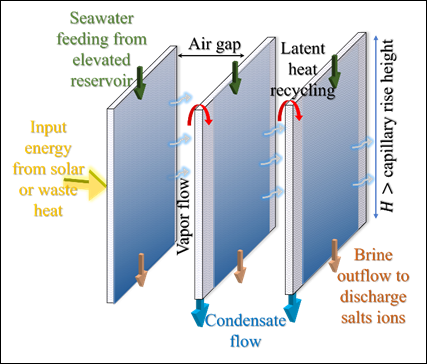A research team from the Indian Institute of Science (IISc) has developed a groundbreaking siphon-powered desalination system that promises to transform seawater into clean drinking water faster, cheaper, and more efficiently than conventional methods. This low-cost, scalable technology has the potential to revolutionize water access in coastal, arid, and disaster-hit regions worldwide.
The Problem with Traditional Solar Stills
Solar stills, which mimic the natural water cycle, have long been considered a simple solution for producing potable water. However, they face two major limitations:
-
Salt buildup: Crystallized salt clogs evaporator surfaces, reducing efficiency.
-
Scaling limits: Wicking materials can lift water only up to 10–15 cm, restricting output and system size.
These challenges have prevented solar stills from becoming a reliable solution for large-scale water purification.
The Siphon-Based Solution
The IISc team tackled both issues using a simple yet powerful principle: siphonage. At the heart of their innovation is a composite siphon made of a fabric wick and a grooved metallic surface.
-
The fabric wick draws saline water from a reservoir.
-
Gravity-driven siphonage prevents salt crystallization by flushing it away continuously.
-
The water flows as a thin film across heated metal, evaporating quickly.
-
Vapor condenses just two millimeters away onto a cooler surface, ensuring highly efficient water recovery.
Record-Breaking Output
The system can produce over six liters of clean water per square meter per hour under sunlight, several times more than conventional solar stills. By stacking multiple evaporator–condenser pairs, the design recycles heat repeatedly, squeezing the maximum output from every ray of sunshine.
Sustainable and Scalable Technology
The unit is built from affordable materials such as aluminum and fabric. It can run on solar energy or waste heat, making it ideal for off-grid villages, island communities, and emergency relief in disaster zones. Importantly, it can handle extremely salty water (up to 20% salt concentration) without clogging—a significant advancement in brine treatment.
Applications and Global Impact
-
Water-stressed regions: Provides safe drinking water in drought-prone areas.
-
Coastal communities: Converts seawater into freshwater without expensive infrastructure.
-
Disaster response: Offers rapid deployment of clean water facilities in emergencies.
-
Sustainability: Reduces dependence on energy-intensive desalination plants.
Recognition and Support
The research, published in the journal Desalination, has been supported by the Department of Science and Technology (DST), Government of India. With its unique combination of scalability, salt resistance, and simplicity, this siphon-powered desalination breakthrough is set to play a pivotal role in addressing global water scarcity.
Conclusion
From small tribal villages to entire island nations, the new siphon-based desalination system represents a promising leap toward universal access to clean drinking water. By making the ocean a dependable source of fresh water, it may help secure the future of millions living in water-stressed regions.





